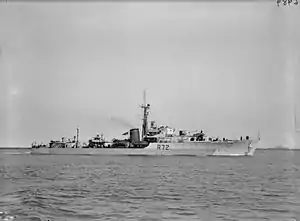 Wizard in May 1945 | |
| History | |
|---|---|
| Name | HMS Wizard |
| Ordered | December 1941 |
| Builder | Vickers Armstrong, Barrow-in-Furness |
| Yard number | 833 |
| Laid down | 14 September 1942 |
| Launched | 29 September 1943 |
| Commissioned | 30 March 1944 |
| Reclassified | Converted to Type 15 frigate 1954 |
| Identification | Pennant number R72/F72 |
| Motto | Endless endeavour |
| Fate | Sold for scrap 16 February 1967 |
| General characteristics as W class | |
| Class and type | W-class destroyer |
| Displacement | |
| Length | 362.75 ft (110.57 m) o/a |
| Beam | 35.75 ft (10.90 m) |
| Draught | 10 ft (3.0 m) |
| Propulsion |
|
| Speed | 36 knots (67 km/h; 41 mph) / 32 knots (59 km/h; 37 mph) full |
| Range | 4,675 nautical miles (8,658 km; 5,380 mi) at 20 knots (37 km/h; 23 mph) |
| Complement | 179 (225 as leader) |
| Sensors and processing systems |
|
| Armament |
|
| General characteristics Type 15 frigate | |
| Class and type | Type 15 frigate |
| Displacement | 2,300 tons (standard) |
| Length | 358 ft (109 m) o/a |
| Beam | 37.75 ft (11.51 m) |
| Draught | 14.5 ft (4.4 m) |
| Propulsion |
|
| Speed | 31 knots (57 km/h; 36 mph) (full load) |
| Complement | 174 |
| Sensors and processing systems | |
| Armament |
|
HMS Wizard was a W-class destroyer of the British Royal Navy that saw service during World War II.
Second World War service
In 1942, as part of Warship Week, Wizard was adopted by the Borough of Wood Green in London. The plaque from this adoption is held by the National Museum of the Royal Navy in Portsmouth.[1]
Wizard was initially deployed to the Home Fleet, before joining a mixed destroyer group on 6 May 1944, assigned to screen for aircraft carriers Furious and Searcher. These duties continued until 9 June 1944, when she sustained major damage from an explosion of her own depth charges, which caused considerable compartment flooding. The ship was towed to Lyness on the following day for emergency dry dock repair, later being towed to Middlesbrough for further repairs which lasted until April 1945. Over this period Wizard was reassigned for deployment to the British Pacific Fleet. After a period of sea-trials and preparation, it made passage to the Pacific, with a final resupply in Sydney, before joining the 27th Destroyer Flotilla in August. Although arriving in theatre before the end of the war, and being listed as part of the British Pacific Fleet present in Tokyo Bay when the surrender was signed on 2 September 1945, Wizard did not receive a Battle Honour as she had not been deployed operationally during the short time she was with the flotilla.[2]
Post War service
From 1946 until 1951 Wizard served in the Plymouth local flotilla.[3] During 1953 and 1954 she was converted at Devonport Dockyard into a Type 15 fast anti-submarine frigate, with the new pennant number F72.[4]
In 1956 Wizard was part of the 5th Frigate Squadron and was deployed to the eastern Mediterranean as part of the Royal Navy force which took part in the Suez Crisis. On return to UK in May 1957 the frigate refitted at Chatham before joining the Dartmouth Training Squadron for two years before being deployed in the West Indies with the 8th Frigate Squadron until 1964. On return she resumed Cadet training and remained with the Dartmouth Squadron until 1966.[4]
Decommissioning and disposal
In 1966 she was paid-off and was reduced to Reserve status. She was then placed on the Disposal List and sold to Thos. W. Ward for demolition on 16 February 1967. Taken in tow to Inverkeithing she arrived at the breaker's yard on 7 March that year.
Commanding officers
| From | To | Captain |
|---|---|---|
| 1950 | 1951 | |
| 1953 | 1954 | Under conversion to Type 15 Frigate |
| 1956 | 1956 | Commander J Jungius RN |
| 1962 | 1963 | Commander W D Jenks RN |
References
- ↑ "Warship Weeks: Adopting Naval Vessels in World War Two". Royal Naval Museum at Portsmouth Historic Dockyard. Archived from the original on 7 February 2012.
- ↑ "Service Histories of Royal Navy Warships in World War 2".
- ↑ Critchley, Mike (1982). British Warships Since 1945: Part 3: Destroyers. Liskeard, UK: Maritime Books. p. 78. ISBN 0-9506323-9-2.
- 1 2 Mason, Geoffrey B. (2001). Gordon Smith (ed.). "HMS Wizard (R 72) - W-class Destroyer". naval-history.net. Retrieved 19 May 2015.
Publications
- Colledge, J. J.; Warlow, Ben (2006) [1969]. Ships of the Royal Navy: The Complete Record of all Fighting Ships of the Royal Navy (Rev. ed.). London: Chatham Publishing. ISBN 978-1-86176-281-8.
- Raven, Alan; Roberts, John (1978). War Built Destroyers O to Z Classes. London: Bivouac Books. ISBN 0-85680-010-4.
- Whitley, M. J. (1988). Destroyers of World War 2. Annapolis, Maryland: Naval Institute Press. ISBN 0-87021-326-1.